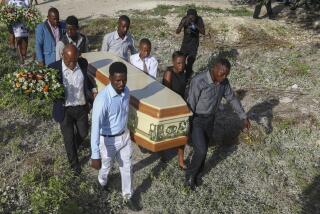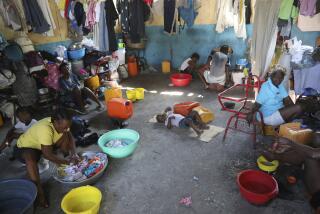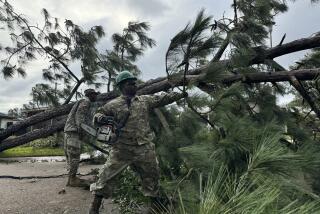250,000 Haitians Left Homeless
PORT-AU-PRINCE, Haiti — In this nation beset by violence, disease and environmental devastation, weary relief workers struggled Tuesday to gauge the magnitude of the latest disaster: torrents of mud and debris from Tropical Storm Jeanne that killed at least 700 people and left 250,000 homeless.
Helicopter reconnaissance tours by United Nations peacekeeping forces and international aid agencies revealed a wide swath of devastation from Jeanne, the most deadly to hit Haiti in an unrelenting string of storms this hurricane season.
Gonaives, a port city of 200,000 near the outflow of the Artibonite River, was hardest hit, with 600 dead and more than 100,000 left homeless. Surveillance flights disclosed that the floods and mudslides had also gutted at least one-third of the homes in Port-de-Paix, an impoverished northern coastal town of 35,000, said Guy Gauvreau, country director for the World Food Program.
The rivers of runoff destroyed homes, farms and roads throughout the mountainous terrain of northern and central Haiti, inflicting as-yet-uncalculated damage to the cities of Hinche, Maissade, Terre Neuve and L’Estere.
“The water runs through so fast because there are no trees left in the valleys,” Gauvreau said. Deforestation in Haiti is widespread because many poor people cut down trees to sell for fuel to get money to feed their families. “The worst part is that this can happen again next week or next month, and it will certainly happen again next year,” he added.
Denuded of the vegetation that once locked fertile mountain soil to rocky hillsides, Haiti suffers flooding after every significant rainfall. In May, the start of the six-month rainy season, walls of mud swept away whole villages in the rural southeast, leaving more than 3,000 dead or missing along the border with the Dominican Republic -- all but about 300 of them on the Haitian side.
Haiti gained independence from France in 1804, but the bicentennial year has brought little to celebrate.
The New Year’s Day pageantry was boycotted by most foreign leaders because of then-President Jean-Bertrand Aristide’s repressive rule and flagrant human rights violations. Next came unrest and street fighting, and an uprising by rebels in Gonaives. At least 300 died in the rebellion before Aristide fled to African exile on Feb. 29. That was followed by the devastating May floods, and then the latest storm, Jeanne.
Jeanne left 18 dead in neighboring Dominican Republic and killed three people in the U.S. territory of Puerto Rico. Although it dealt Haiti only a glancing blow, the confirmed death toll exceeded 700 on Tuesday “and is expected to continue rising,” said Myrna Domit, a spokeswoman with the U.N. peacekeeping force here.
So ravaged is the Haitian countryside that the relief efforts underway often seem futile. Those flooded out of their homes in Gonaives lost all their belongings, including pots and stoves for cooking the rice and beans that agencies raced to bring them.
Wells have been contaminated, forcing emergency water deliveries by tanker across the only road linking Port-au-Prince, the capital, to Gonaives -- a 70-mile drive that takes four hours even in the dry season. Now, the road has been washed away in six or seven places.
Waist-deep water has turned the aptly named Savane Desolee (Desolate Swamp), south of Gonaives, into a lake that can be negotiated only by six-wheel, all-terrain vehicles, Gauvreau said. And because rebels destroyed police stations, municipal offices and hospitals as they converged on the capital in February, there are no public facilities at which shelters and soup kitchens can be set up.
Telephones have been out of service through much of the north since the February rebellion, limiting communication to the few radio-equipped relief agencies in the region. Electricity has been off for several days, leaving survivors to spend the night in utter darkness in trees and on rooftops.
Bakeries were working around the clock to produce bread, and a work-for-food program was to be implemented to enlist those who lost their homes in the rebuilding effort, Gauvreau said.
A Haitian Interior Ministry official estimated the homeless at a quarter of a million. At least 1,000 people are missing from the flooded areas, stoking fears the death toll could more than double.
Aid workers and foreign soldiers gathered bloated corpses floating in the streets and in inundated hovels. The bodies filled Gonaives’ hospital, which, devoid of doctors or medical supplies since the rebellion, was being used as a morgue, said Jean Pierre, a Red Cross doctor.
“There is definitely a public health threat of diarrhea, fever, malaria, all kinds of infections,” said Pierre. International aid officials were discussing how to dispose of the corpses before decomposition imposed a further health risk.
“This is the incubation period,” he said. “It will be three or four days before we see the real consequences.”
More to Read
Sign up for Essential California
The most important California stories and recommendations in your inbox every morning.
You may occasionally receive promotional content from the Los Angeles Times.











